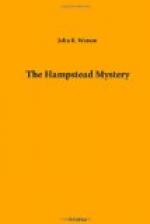The question of when the murder was committed was regarded as important. Dr. Slingsby, of the Home Office, who had examined the body shortly after it was discovered by the police, was of opinion that death had taken place at least twelve hours before and probably longer than that. His opinion on this point lent support to the theory that the murder had been committed before midnight on Wednesday. It was the Daily Record that seized on the mystery contained in the facts that the body when discovered was fully clothed and that the electric lights were not turned on. If the murder was committed late at night how came it that there were no lights in the empty house when the police discovered the body? Had the murderer, after shooting his victim, turned out the lights so that on the following day no suspicion would be created as would be the case if anyone saw lights burning in the house in the day-time? If he had done so, he was a cool hand. But if the burglar was such a cool hand as to stop to turn out the lights after the murder why did he not also stop to collect some valuables? Was he afraid that in attempting to get rid of them to a “fence” or “drop” he would practically reveal himself as the murderer and so place himself in danger in case the police offered a reward for the apprehension of the author of the crime?
If Sir Horace had gone to bed before the murderer entered the house it would have been natural to expect no lights turned on. But he had returned unexpectedly; there were no servants in the house, and there was no bed ready for him. In any case, if he intended stopping in the empty house instead of going to a hotel he would have been wearing a sleeping suit when his body was discovered; or, at most, he would be only partially dressed if he had got up on hearing somebody moving about the house. But the body was fully dressed, even to collar and tie. It was absurd to suppose that the victim had been sitting in the darkness when the murderer appeared.
Another difficult problem Scotland Yard had to face was the discovery of the person who had sent them the news of the murder. How had Scotland Yard’s anonymous correspondent learned about the murder, and what were his motives in informing the police in the way he had done? Was he connected with the crime? Had the murderer a companion with him when he broke into Riversbrook for the purpose of burglary? That seemed to be the most probable explanation. The second man had been horrified at the murder, and desired to disassociate himself from it so that he might escape the gallows. The only alternative was to suppose that the murderer had confessed his crime to some one, and that his confidant had lost no time in informing the police of the tragedy.




